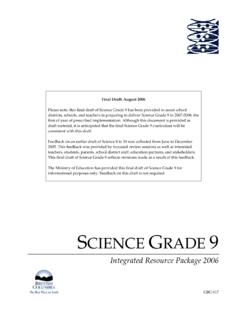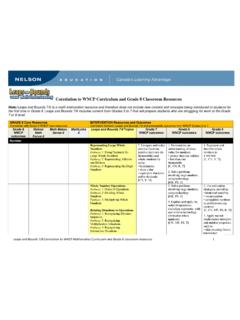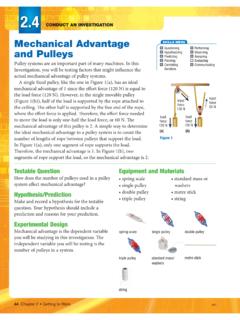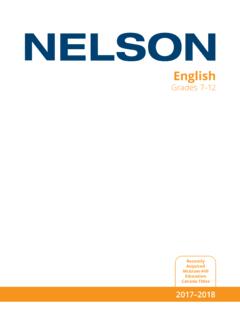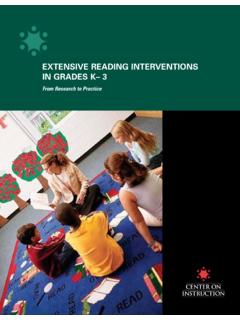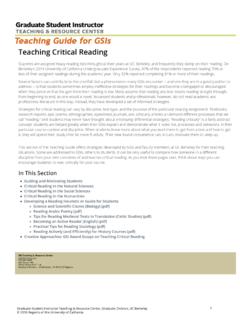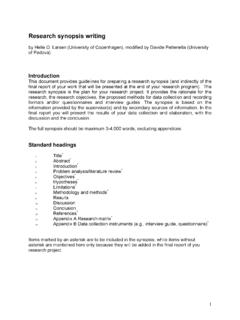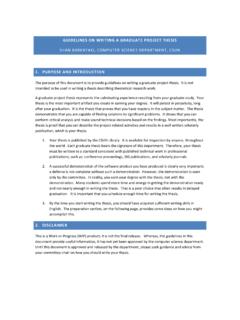Transcription of The Research Behind Leaps and Bounds Grades 3 to 8
1 The Research Behind Leaps and Bounds Grades 3 to 8 Leaps and Bounds toward Math Understanding is a comprehensive resource that provides diagnostic tools and remediation/intervention lessons for students who are struggling in Grades 3 to 8 mathematics in all five strands. The approach used in Leaps and Bounds respects what we know about how students learn by sequencing the content in a developmentally appropriate way and providing alternatives in approach that allow for differentiated instruction. Leaps and Bounds has a solid Research foundation that reflects the following: developmental learning of mathematics, as determined from the PRIME Research ; recognized common areas of difficulty in mathematics that students have, and Research in best instructional practices for addressing these areas of difficulty; and current Research around how to support students who are struggling in math; in particular, addressing both different learning styles and alternative strategies for learning a mathematical concept.
2 Developmental Learning in Mathematics Dr. Marian Small conducted Research across Canada to collect data about how elementary students learn mathematics. The Research was conducted between 2002 and 2004 in seven provinces with 12,000 students from kindergarten to grade 7. The data collected was the foundation for the developmental maps published under the name of PRIME (Professional Resources and Instruction for Math Educators). PRIME is a Canadian Research -based professional learning initiative designed to assist teachers, administrators and district personnel to improve elementary school mathematics instruction and learning. Developmental maps were created for the five strands. The maps describe the phases that students travel through as they learn mathematics, and indicate key behaviors that students exhibit at each phase. The maps also reflect the curriculum that is taught in elementary schools across Canada.
3 There are eight maps altogether: Number, Operations, Patterns, Algebra, Measurement, Geometry, Data Management, and Probability. Each map has two versions, a Phases and Indicators Map and a Visual Overview Map (see below). The maps group the key student behaviours by key concepts or big ideas. The Phases and Indicators Map describes the behaviors as key indicators and the Visual Overview Maps show what those indicators look like. Below is the Phase and Indicators map and related Visual Overview Map for one of the big concepts or big ideas in Patterns and Algebra, Concept 4: Data can be arranged to highlight patterns and relationships. The maps clearly describe and show how a student develops in his or her understanding of patterns and relationships across four phases. The Research Behind Leaps and Bounds Grades 3 to 8 April 2011 page 2 Note that the Research indicated that these phases are not strictly tied to specific grade levels; for example, although most students in Phase 1 are in the early primary Grades , there are students in the later elementary Grades that are still in Phase 1 and students in the primary Grades that are in Phase 2 or 3.
4 The maps help teachers determine what the next steps are for each student, regardless of grade level. Developmental Learning and Leaps and Bounds The information provided by the PRIME Research and the resulting developmental maps was invaluable in the creation of Leaps and Bounds . Carefully sequenced interventions were created based on what we know about development in mathematics and the mathematics curriculum. For example, in Geometry, we know from the Research that students develop in their ability to work with representations of 3-D shapes, from working with more concrete models, such as geometric solids and clay models, to more abstract models such as skeletons and nets. So, in Leaps and Bounds Grades 5/6, three different intervention pathways have been created to reflect this. Pathway 1: Modelling With Nets Pathway 2: Modelling With Skeletons Pathway 3: Modelling With Solid Shapes These pathways re-teach the critical concepts Behind 3-D representations.
5 A diagnostic tool that highlights the common difficulties that students have is provided to allow a teacher to determine which pathway is required for an individual student. Although a student who is significantly Behind might be assigned Pathway 3, it is not always necessary for the student to then complete Pathway 2 and then Pathway 1. After completing Pathway 3, the teacher can reassign the appropriate diagnostic questions from the tool to ascertain whether more intervention is required. Leaps and Bounds allows teachers to re-teach the critical concepts Behind each topic in a developmentally appropriate way. Common Areas of Difficulty in Mathematics Most teachers know from experience where students tend to have difficulty in mathematics. As well, there is ample Research on this (see the References). And, one of the interesting byproducts of the PRIME Research was, while trying to determine how students learn mathematics, common areas of difficulty surfaced, thus providing another source of information about common areas of difficulty.
6 Certainly an understanding of developmental learning in math can assist in remediating these common difficulties, as some of these arise from students being introduced to concepts before they are ready for them or because students are introduced to concepts in a developmentally inappropriate way. However, we know from the Research that there are also specific strategies we can use to target some of the difficulties. Common Areas of Difficulty and Leaps and Bounds Simply by creating pathways that reflect what we know about how students develop in their understanding of mathematics will go a long way to help students. However, Leaps and Bounds also uses what we know about where and why students struggle in mathematics and how to help them, as a basis to develop the different intervention pathways. So, the pathways not only allow students an opportunity to re-examine concepts in a conceptually meaningful way but also include tasks and questions that target common areas of difficulty.
7 As well, in the Leaps and Bounds Teacher Resource, teachers are provided with a list of what the common areas of difficulty are. They are also provided with key behaviours to look for and key questions to ask as students work, which focus on the critical concepts and the common areas of difficulty. For example, the Teachers Resource for Leaps and Bounds grade 3/4, Topic: Skip Counting, provides the following information in the front matter to the topic: The Research Behind Leaps and Bounds Grades 3 to 8 April 2011 page 3 In each of the three intervention pathways for the Skip Counting topic (Skip Counting to 1000, Skip Counting to 100, and Skip Counting to 10), there are opportunities for students to work on questions and tasks that require students to make transitions where more than one digit changes, skip count from different starting numbers, and skip count backwards For example, here are two questions from the Skip Counting to 1000 intervention pathway: In the teachers resource for this pathway, teachers are provided with these key observational indicators.
8 Knowing where students struggle and why, what to watch and what questions to ask, prepares teachers for assisting students while they work on tasks that are designed to re-teach a topic while focusing on the critical concepts and common areas of difficulty. The Research Behind Leaps and Bounds Grades 3 to 8 April 2011 page 4 Current Research on Supporting Struggling Students Current Research on supporting struggling students suggests the need to incorporate the following in any remediation program: Differentiated Instruction Conceptually-based explicit instruction Visual representation Meaningful practice Scaffolding Math Discussion Differentiated Instruction and Leaps and Bounds To differentiate instruction for any student or group of students, both the content that we want students to learn and the strategies or approach used to teach the content can be individualized.
9 Leaps and Bounds does both. Individualizing Content As described earlier, each topic in each strand provides multiple intervention pathways for students to follow, depending on their individual needs. In the teachers resource for each topic, a diagnostic tool is provided that teachers can administer to students to help decide which pathway is most suitable for the student or group of students. In this way, the content that students are exposed to can be individualized. For example, in Leaps and Bounds Grades 3/4, Topic: Fractions, there is a diagnostic tool that has been crafted to determine what content students are struggling with. We know from the Research (both the PRIME Research and Research on common areas of difficulty), that learning about fractions of a set requires more sophistication than fractions of a region and that the concept of a half is usually a student s first exposure to the topic of fractions.
10 That is why there are three pathways provided (Fractions as Parts of Sets, Fractions as Parts of Regions, and Halves). To determine which pathway is most suitable, the questions on the Tool have been organized such that, if students have difficulty with certain questions and not others, it indicates a specific pathway (as shown in the chart below). The Research Behind Leaps and Bounds Grades 3 to 8 April 2011 page 5 Individualizing Instructional Approaches Once a teacher has determined which pathway is most suitable, the teacher has another choice to make, that is, whether they use a more open approach (the Open-Ended Intervention) or a guided approach (the Guided Intervention). In this way, the instructional approach can also been individualized or differentiated. The two approaches or types of intervention cover the same content but in different ways: The Research Behind Leaps and Bounds Grades 3 to 8 April 2011 page 6 The Open interventions typically provide a brief introduction with minimal instruction, often in a context, followed by a problem to solve or task that has multiple possible solutions.




